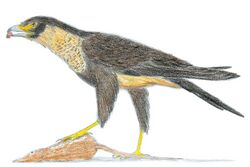Biology:Masillaraptor
| Masillaraptor | |
|---|---|

| |
| Life restoration based on modern falconiformes | |
| Scientific classification | |
| Domain: | Eukaryota |
| Kingdom: | Animalia |
| Phylum: | Chordata |
| Class: | Aves |
| Order: | Falconiformes |
| Family: | †[[Biology:|Masillaraptoridae]] |
| Genus: | †Masillaraptor Mayr, 2006 |
| Species: | †M. parvunguis
|
| Binomial name | |
| †Masillaraptor parvunguis Mayr, 2006
| |
Masillaraptor is an extinct genus of masillaraptorid, a group of primitive falconiforms, from the Middle Eocene Messel Pit, Germany. It is a long-legged relative of the living falcons.[1][2]
Known species
Only one species of Masillaraptor is known: M. parvunguis
Etymology
Masillaraptor comes from the Latin word Masilla, which is the old name for the town of Messel, and raptor is a New Latin suffix used to indicate a predator (from rapere, to catch) and in English it means bird of prey.
Specific epithet parvunguis is also Latin, coming from the word parvus which means small and feeble, while unguis means claw.
The name refers to the fact that the specimen's claws are small in comparison to those of other raptors.
Characteristics
The genus Masillaraptor is different from all other known avian taxa. It possesses a combination of characters that distinguishes it from all others.
1. The beak is almost as long as the cranium itself, with equal height over much of its length and a straight dorsal ridge. The beak curves just before its tip, restricting the nasal openings to the rear half of the beak.
2. The tibiotarsus is the longest bone in the leg.
3. On the second toe the first phalanx is shortened, whereas on the fourth toe the second and third phalanges are shortened.
4. The claws of Masillaraptor are small and weak compared to other falconiform birds with abbreviated pedal phalanges.
Characters (1) and (3) are derived within neornithine birds and also found in modern Accipitres, from which Masillaraptor is, however, distinguished in character (4).(Mayr, 2006.)
Fossil specimens
There are two specimens of Masillaraptor. Only one specimen was referenced for classification because the other is housed in an unknown private collection. Both specimens are a slab of rock containing a nearly complete, articulate but poorly preserved skeleton. The specimens are both believed to be adult members of the species. Both specimens were discovered in the Messel pit, an old shale mine known for the extremely well preserved fossils that have been discovered there.
Classification
Masillaraptor represents one of two members of Masillaraptoridae within the Falconiformes. The cladogram below displays the results of the phylogenetic analysis by Mayr & Kitchener (2022):[3]
| |||||||||||||||||||||||||||||||||||||||||||||||||
References
- ↑ Mayr, G. (2006) A new raptorial bird from the Middle Eocene of Messel, Germany. Historical Biology, 18(2): 95–102
- ↑ "New fossils from the London Clay show that the Eocene Masillaraptoridae are stem group representatives of falcons (Aves, Falconiformes)". Journal of Vertebrate Paleontology 41 (6): e2083515. 2022. doi:10.1080/02724634.2021.2083515.
- ↑ Mayr, Gerald; Kitchener, Andrew C. (2022-07-08). "New fossils from the London Clay show that the Eocene Masillaraptoridae are stem group representatives of falcons (Aves, Falconiformes)" (in en). Journal of Vertebrate Paleontology 41 (6): e2083515. doi:10.1080/02724634.2021.2083515. ISSN 0272-4634.
External links
Wikidata ☰ Q2473105 entry
 |

